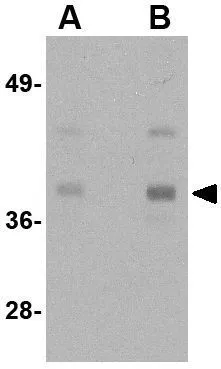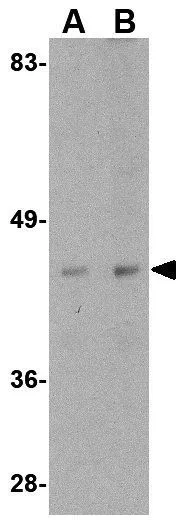beta Actin antibody
GTX110564
ApplicationsImmunoFluorescence, ImmunoPrecipitation, Western Blot, ImmunoCytoChemistry, ImmunoHistoChemistry, ImmunoHistoChemistry Paraffin
Product group Antibodies
TargetACTB
Overview
- SupplierGeneTex
- Product Namebeta Actin antibody
- Delivery Days Customer9
- Application Supplier NoteWB: 1:5000-1:20000. ICC/IF: 1:100-1:1000. IHC-P: 1:100-1:1000. IP: 1:100-1:1000. *Optimal dilutions/concentrations should be determined by the researcher.Not tested in other applications.
- ApplicationsImmunoFluorescence, ImmunoPrecipitation, Western Blot, ImmunoCytoChemistry, ImmunoHistoChemistry, ImmunoHistoChemistry Paraffin
- CertificationResearch Use Only
- ClonalityPolyclonal
- Concentration0.26 mg/ml
- ConjugateUnconjugated
- Gene ID60
- Target nameACTB
- Target descriptionactin beta
- Target synonymsBKRNS, BNS, BRWS1, CSMH, DDS1, PS1TP5BP1, THC8, actin, cytoplasmic 1, I(2)-actin, PS1TP5-binding protein 1, beta cytoskeletal actin
- HostRabbit
- IsotypeIgG
- Protein IDP60709
- Protein NameActin, cytoplasmic 1
- Scientific DescriptionThis gene encodes one of six different actin proteins. Actins are highly conserved proteins that are involved in cell motility, structure, and integrity. This actin is a major constituent of the contractile apparatus and one of the two nonmuscle cytoskeletal actins. [provided by RefSeq]
- Storage Instruction-20°C or -80°C,2°C to 8°C
- UNSPSC12352203
References
- Shimada M, Tokumiya T, Miyake T, et al. Implication of E3 ligase RAD18 in UV-induced mutagenesis in human induced pluripotent stem cells and neuronal progenitor cells. J Radiat Res. 2023,64(2):345-351. doi: 10.1093/jrr/rrac099Read this paper
- Young MJ, Chen YC, Wang SA, et al. Estradiol-mediated inhibition of Sp1 decreases miR-3194-5p expression to enhance CD44 expression during lung cancer progression. J Biomed Sci. 2022,29(1):3. doi: 10.1186/s12929-022-00787-1Read this paper
- Chao TY, Hsieh CC, Kuo YH, et al. Bracteanolide A abrogates oxidative stress-induced cellular damage and protects against hepatic ischemia and reperfusion injury in rats. Food Sci Nutr. 2021,9(9):4758-4769. doi: 10.1002/fsn3.2374Read this paper
- Dai J, Li Y, Kametani F, et al. Curcumin promotes AApoAII amyloidosis and peroxisome proliferation in mice by activating the PPARα signaling pathway. Elife. 2021,10. doi: 10.7554/eLife.63538Read this paper
- Wang SA, Young MJ, Jeng WY, et al. USP24 stabilizes bromodomain containing proteins to promote lung cancer malignancy. Sci Rep. 2020,10(1):20870. doi: 10.1038/s41598-020-78000-2Read this paper
- Brahma MK, Ha CM, Pepin ME, et al. Increased Glucose Availability Attenuates Myocardial Ketone Body Utilization. J Am Heart Assoc. 2020,9(15):e013039. doi: 10.1161/JAHA.119.013039Read this paper
- Satou R, Shibukawa Y, Kimura M, et al. Light conditions affect rhythmic expression of aquaporin 5 and anoctamin 1 in rat submandibular glands. Heliyon. 2019,5(11):e02792. doi: 10.1016/j.heliyon.2019.e02792Read this paper
- Khanal S, Galloway DA. High-risk human papillomavirus oncogenes disrupt the Fanconi anemia DNA repair pathway by impairing localization and de-ubiquitination of FancD2. PLoS Pathog. 2019,15(2):e1007442. doi: 10.1371/journal.ppat.1007442Read this paper
- Nashine S, Cohen P, Nesburn AB, et al. Characterizing the protective effects of SHLP2, a mitochondrial-derived peptide, in macular degeneration. Sci Rep. 2018,8(1):15175. doi: 10.1038/s41598-018-33290-5Read this paper
- Gong W, Qie S, Huang P, et al. Deletion of long noncoding RNA EFNA3 aggravates hypoxia-induced injury in PC-12 cells by upregulation of miR-101a. J Cell Biochem. 2019,120(1):836-847. doi: 10.1002/jcb.27444Read this paper




